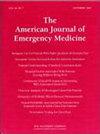Brain natriuretic peptide as a predictor of 30-day mortality after return of spontaneous circulation in cardiac arrest patients
IF 2.2
3区 医学
Q1 EMERGENCY MEDICINE
引用次数: 0
Abstract
Purpose
To determine the predictive value of brain natriuretic peptide (BNP) levels for 30-day mortality after return of spontaneous circulation (ROSC) in patients with cardiac arrest (CA) of presumed cardiac etiology.
Methods
This retrospective study included 260 patients with CA of presumed cardiac etiology who regained ROSC and was conducted between November 2013 and June 2022 at two tertiary comprehensive hospitals. Cox regression and nomogram models were used to demonstrate the value of BNP level in predicting 30-day mortality rates. Net reclassification improvement (NRI) and integrated discrimination improvement (IDI) were used to compare the ability of the two models to predict 30-day mortality risk.
Results
BNP level was a predictive factor for 30-day mortality (hazard ratio [HR] = 1.441; 95 % confidence interval [CI] = 1.198–1.734). The area under curves (AUCs) of BNP level alone and model 2 (male sex, age, non-shockable rhythm, epinephrine, and time to ROSC >30 min) for predicting 30-day mortality were similar(0.813 versus 0.834). Model 1 that included the variables in model 2 and BNP level showed good predictive value (area under curve = 0.887; 95 % CI = 0.836–0.939). Compared to Model 2, Model 1 showed improved comprehensive differentiation and net weight classification of mortality prediction, further demonstrating the predictive value of BNP for 30-day mortality (NRI = 0.451, 95 % CI = 0.267–0.577; IDI = 0.109, 95 % CI = 0.035–0.191).
Conclusion
BNP level was a predictive factor for 30-day mortality after ROSC in patients with CA of presumed cardiac etiology who regained ROSC. The nomogram model included BNP may provide a reference for predicting 30-day mortality.
脑钠肽是预测心脏骤停患者恢复自主循环后 30 天死亡率的指标。
目的:确定脑钠肽水平对推测为心脏病因的心脏骤停(CA)患者恢复自主循环(ROSC)后 30 天死亡率的预测价值:这项回顾性研究纳入了260名推测为心脏病因的心脏骤停患者,他们都恢复了ROSC,研究于2013年11月至2022年6月期间在两家综合性三级医院进行。研究采用 Cox 回归和提名图模型来证明 BNP 水平在预测 30 天死亡率方面的价值。净重分类改进(NRI)和综合判别改进(IDI)用于比较两种模型预测30天死亡率风险的能力:结果:BNP 水平是 30 天死亡率的预测因素(危险比 [HR] = 1.441;95 % 置信区间 [CI] = 1.198-1.734)。单独使用 BNP 水平和模型 2(男性性别、年龄、非休克心律、肾上腺素和 ROSC 时间大于 30 分钟)预测 30 天死亡率的曲线下面积(AUC)相似(0.813 对 0.834)。包含模型 2 中的变量和 BNP 水平的模型 1 显示出良好的预测价值(曲线下面积 = 0.887;95 % CI = 0.836-0.939)。与模型 2 相比,模型 1 在死亡率预测的综合分化和净重分类方面有所改进,进一步证明了 BNP 对 30 天死亡率的预测价值(NRI = 0.451,95 % CI = 0.267-0.577;IDI = 0.109,95 % CI = 0.035-0.191):结论:BNP水平是心源性CA患者恢复ROSC后30天死亡率的预测因素。包含 BNP 的提名图模型可为预测 30 天死亡率提供参考。
本文章由计算机程序翻译,如有差异,请以英文原文为准。
求助全文
约1分钟内获得全文
求助全文
来源期刊
CiteScore
6.00
自引率
5.60%
发文量
730
审稿时长
42 days
期刊介绍:
A distinctive blend of practicality and scholarliness makes the American Journal of Emergency Medicine a key source for information on emergency medical care. Covering all activities concerned with emergency medicine, it is the journal to turn to for information to help increase the ability to understand, recognize and treat emergency conditions. Issues contain clinical articles, case reports, review articles, editorials, international notes, book reviews and more.

 求助内容:
求助内容: 应助结果提醒方式:
应助结果提醒方式:


